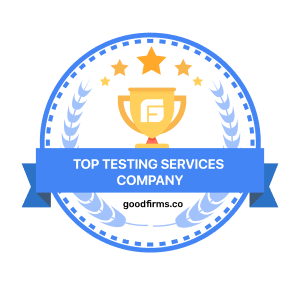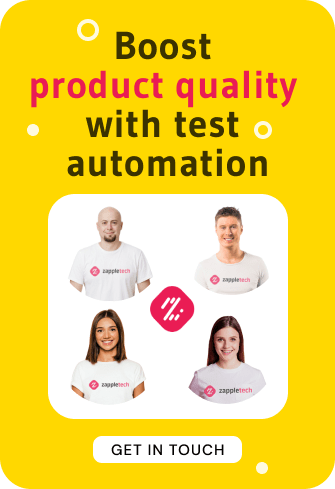Automated QA Outstaffing


Why Choose Us for Automated QA Outstaffing?
Why Outstaff QA Is Your Viable Option
When You Need QA Outstaffing
Industries We Work With
What Our Customers Say
Our Expertise

Outstaffing’s Challenges
Start Cooperation Now!

Why Should You Choose Automated QA Outstaffing?
Outstaffing is a business model where a company hires remote specialists who are officially employed by another company (the outstaffing provider) but work exclusively for the hiring company. This approach allows businesses to extend their team with skilled professionals without the long-term commitments and overhead costs associated with full-time, in-house employees. In the context of quality assurance (QA), outstaffing enables companies to augment their QA teams with experts in automated testing tools and practices, enhancing their QA processes’ overall efficiency and effectiveness.
Difference Between Outstaffing, Outsourcing, and In-House Teams
To fully grasp the concept of outstaffing, it is crucial to distinguish it from outsourcing and maintaining in-house teams:
Outstaffing | As mentioned, outstaffing involves hiring remote workers from an external provider to work exclusively on the hiring company’s projects. These workers integrate seamlessly into the company’s existing teams and processes, often working alongside in-house employees. |
Outstaffing | On the other hand, outsourcing involves contracting entire projects or specific functions to an external organization. The outsourcing provider takes full responsibility for delivering the project, often with little to no integration into the client’s internal processes. |
In-House Teams | In-house teams work directly for the company and are based at the company’s premises. These employees fully integrate into the company’s culture and processes but have higher overhead costs and long-term commitments. |
Benefits of Outstaffing for Software Development Companies
Outstaffing, particularly automated QA outstaffing, offers numerous advantages for software development companies:
- Access to Expertise: Companies can tap into a global talent pool of QA professionals with specialized skills in automated testing. This access allows companies to leverage the latest tools and techniques without extensive training and development.
- Cost-Effectiveness: Outstaffing reduces the financial burden of hiring full-time employees, such as recruitment, benefits, and office space. It also allows companies to scale their QA efforts up or down based on project demands, optimizing resource allocation and cost management.
- Flexibility and Scalability: Automated outstaffing allows for quick adjustment of team sizes and capabilities to meet project requirements. This agility is particularly valuable in fast-paced development environments where project scopes and timelines change rapidly.
- Focus on Core Business Activities: By delegating the QA function to outstaffed professionals, companies can concentrate on their core business activities and strategic goals while still ensuring high-quality software development.
Challenges Associated with Outstaffing
While automated QA outstaffing presents many benefits, it also comes with its own set of challenges:
- Communication and Collaboration: Managing remote teams can lead to communication barriers, especially when team members are spread across different time zones and cultural backgrounds. Effective communication tools and practices are essential to bridge these gaps and ensure seamless collaboration.
- Data Security and Confidentiality: Working with external teams raises concerns about data security and confidentiality. It is crucial to implement robust security measures and non-disclosure agreements (NDAs) to protect sensitive information and maintain trust.
- Integration with In-House Processes: Integrating outstaffed QA professionals with existing in-house teams and processes can be challenging. It requires clear guidelines, regular updates, and consistent methodologies to ensure alignment and coherence.
Mitigating Challenges in Automated QA Outstaffing
To overcome the challenges associated with QA outstaffing, companies can adopt several strategies:
- Effective Communication Tools and Practices: Utilizing modern communication platforms such as Slack, Microsoft Teams, and video conferencing tools can enhance real-time collaboration. Regular meetings, status updates, and clear documentation help keep everyone on the same page.
- Strong Contractual Agreements and NDAs: Establishing comprehensive contracts and NDAs with the outstaffing provider ensures that all parties understand their responsibilities and the importance of data security and confidentiality.
- Seamless Integration Strategies: Implementing well-defined processes and integration strategies helps to align outstaffed teams with in-house operations. This includes onboarding sessions, regular training, and adopting common tools and methodologies.
In summary, automated QA outstaffing offers significant benefits regarding expertise, cost-effectiveness, and flexibility. However, to fully realize these advantages, companies must address the associated challenges through effective communication, robust security measures, and seamless integration practices. By doing so, they can leverage the power of outstaffed automated QA to enhance their software development processes and achieve higher-quality outcomes.
The Synergy of Automated QA and Outstaffing
Automated outstaffing leverages the strengths of both automation and remote staffing to create a powerful combination that enhances the software development process. Several factors drive this synergy:
- Streamlined Processes: Human-software collaboration is enabled through the automation of QA outsourcing. Since routine tasks are well adapted by automated tools, they reduce the burden on the staff to handle repetitive and time-consuming testing tasks while giving the team time and opportunity to focus on the creative and ingenious aspects of QA. Streams are very valuable for the teams. When remote workers are outstaffed, management could be a challenge, and this is when automated clear workflows come in handy.
- 24/7 Testing Capabilities: Owing to remotely located offshore QA teams and cross-timing of visits, fully-fledged automated testing can be done 24/7. This never-ending testing keeps validation of defects at a faster pace, leading to a shorter duration of development cycles and, worse yet, a faster time to market.
Increased Efficiency and Productivity
Automated QA outstaffing significantly boosts efficiency and productivity in several ways:
- Reduced Manual Effort: Test automation tools are proficient for tasks that would otherwise take the QA engineers a long time to accomplish by hand, and thus, less labor is needed for them to complete the tasks. It permits, particularly, to devote resources to significant problems and creative testing that can not be covered by automation, which needs people and their thinking.
- Parallel Testing: Automation QA tools are capable, for instance, of provisioning multiple tests simultaneously on various platforms and settings. This automated parallel testing provides a faster testing process and allows for more extensive coverage, which allows for the development of better-quality software.
- Consistent and Reliable Results: Automated tests give the same test outcomes, and no one will get different results, unlike when everything was done manually, and people might not have done the same. Sticking to the process means that the QA process becomes even more trustworthy and raises the quality of the end result.
Cost-Effectiveness and Scalability
Automated QA outstaffing is a cost-effective solution that offers scalability to meet varying project demands:
- Lower Operational Costs: By outstaffing QA roles, companies can avoid the high costs associated with hiring and maintaining in-house staff. Automated testing reduces costs by minimizing the need for extensive manual testing and associated resources.
- Scalable Resources: Outstaffing allows companies to easily scale their QA teams up or down based on project needs. This flexibility ensures that resources are optimally utilized without incurring unnecessary expenses during periods of low demand.
- Efficient Resource Allocation: QA outstaffing enables efficient resource allocation by leveraging remote specialists who bring advanced skills and expertise. This model ensures that the right talent is available when required without the long-term commitments of full-time hires.
Access to Specialized Skills and Advanced Technologies
Automated QA outstaffing provides access to a global talent pool with specialized skills and expertise in advanced QA technologies: Automated outstaffing provides access to a global talent pool with specialized skills and expertise in advanced QA technologies:
- Expertise in Automation Tools: Bear specialists in software testing, working on demand, usually have profound knowledge regarding the recent capabilities of the automation techno-stack, which relies on Selenium, Appium, and JUnit. This means that they assist in making the automated testing process efficient, effective, and compliant with industry standards.
- Advanced Testing Techniques: With outstaffing, businesses can hire people who are experts in each type of testing and have extensive experience in more advanced testing methods, such as performance testing, security testing, and the Continuous Integration/Continuous Delivery (CI/CD) toolchain. This greatly increases the effectiveness of the QA process with time.
- Innovative Approaches: Teams that outsource testing personnel have a blended history of experiences that challenge QA issues using new methods. Their involvement alongside different projects and companies helps them carry out optimal implementation and use of advanced methods in the company’s testing practice.
Benefits of Automated QA Outstaffing
Automated outstaffing offers unparalleled flexibility in managing QA resources, allowing companies to adapt to changing project requirements seamlessly.
- Scalable Teams: Companies can scale QA teams on-demand or on-demand based on project requirements. With this flexibility, resources always suit project demands, thus increasing productivity through an efficient cost structure.
- On-Demand Expertise: Of course, automated QA outsourcing can allow firms to obtain the right specialists from a wide range of proven experts in various testing tools and methodologies. Firms can bring in members of external expert networks only when their help is needed, although there will be no need for any long-term promises.
- Dynamic Allocation: They can be freely transferred between projects or phases. This gives the chance to apply the best skills at the correct place. Flexibility plays a key role in the agile development life cycle, where priorities may change at any moment.
Improved Focus on Core Business Activities
By leveraging automated QA outstaffing, companies can focus more on their core business activities and strategic initiatives, rather than being bogged down by the complexities of QA processes.
- Delegation of QA Tasks: Automated QA outstaffing allows companies to delegate testing tasks to specialized professionals, freeing up internal teams to concentrate on product development, innovation, and market strategies.
- Resource Optimization: With QA functions efficiently managed by outstaffed teams, internal resources can be optimized for other critical business functions. This leads to better resource allocation and enhanced overall productivity.
- Strategic Focus: Companies can focus strategically on their core competencies and business goals, confident that their software quality is in expert hands. This strategic alignment is crucial for long-term growth and competitive advantage.
In summary, QA outstaffing offers significant benefits, including faster time-to-market, enhanced software quality and reliability, flexible resource management, and improved focus on core business activities. By integrating automated outstaffing into their development processes, companies can achieve higher efficiency, better quality outcomes, and greater strategic alignment, positioning themselves for success in the competitive software market.
Challenges and Considerations
On the one hand, automated QA outsourcing carries a number of benefits, yet on the other hand, it has several issues that must be resolved in order to achieve a flowless deployment and management process.
Communication and Collaboration Issues
- Time Zone Differences: Along with it, matters of coordination and communication become a barrier to cooperation. Thus, this may hinder decision-making and, as a result, reduce the achievement of the project.
- Cultural Differences: Diversity may bring about different work methods, interactions, and argumentation patterns, possibly leading to miscommunication and disputes.
- Remote Coordination: Directing the activities and teamwork among members is not an easy goal when working remotely. Ensuring that everyone understands the things being discussed and is committed to common goals is imperative. The use of suggested communication strategies and tools will help achieve the same.
Data Integrity and Sureness/Confidentiality Issues
- Sensitive Information: Disclosure of certain information and valuable ideas, especially to a third-party team who are not perfectly familiar with their personnel, is a serious security risk. Keeping data disciplined and exposed to the public view or containing unauthorized entities is an important element of safeguarding the company’s resources.
- Compliance Requirements: Organizations must abide by rules of these kinds when they process data, and the requirements of addressing them will be the highest in the financial and health industry. Complying with these laws while monitoring and guiding the multiple outsourced workgroups adds one more difficulty factor.
Integration with In-House Processes
- Process Alignment: Integrating the outstaffed QA teams with the in-house processes is not easy, especially when the teams use different approaches, technologies, tools, and procedures. It is vital to remain on pace and align all the work to keep the process running and consistent with high-level quality standards.
- Tool Compatibility: The tools and technologies for the outsourced or in-house teams may not match, resulting in differences in the resources provided. Achieving such privacy and security measures is crucial for avoiding any disruption during development processes.
Strategies to Mitigate These Challenges
To effectively manage the challenges associated with automated QA outstaffing, companies can adopt several strategies:
Effective Communication Tools and Practices
- Unified Communication Platforms: Utilizing communication platforms like Slack, Microsoft Teams, or Zoom can facilitate real-time communication and collaboration. These tools enable instant messaging, video conferencing, and file sharing, helping to bridge the gap between remote and in-house teams.
- Regular Updates and Meetings: Scheduling regular check-ins, stand-up meetings, and progress updates helps keep all team members informed and aligned. This practice fosters transparency and ensures that any issues are promptly addressed.
- Clear Documentation: It is crucial to maintain clear and comprehensive documentation of processes, requirements, and expectations. This ensures that everyone understands their roles and responsibilities, reducing the likelihood of misunderstandings.
Strong Contractual Agreements and NDAs
- Comprehensive Contracts: It is essential to draft detailed contracts that outline the scope of work, deliverables, timelines, and payment terms. These contracts should also include clauses addressing data security, confidentiality, and compliance requirements.
- Non-Disclosure Agreements (NDAs): Implementing NDAs with outstaffing providers and individual team members helps protect sensitive information and intellectual property. NDAs should specify the consequences of any breaches and ensure that all parties know their obligations.
- Security Protocols: It is vital to establish robust security protocols and require outstaffed teams to adhere to them. This includes safeguarding data through secure communication channels, encryption, and access controls.
Seamless Integration Strategies
- Standardized Tools and Processes: Adopting standardized tools and processes that in-house and outstaffed teams can use ensures compatibility and smooth integration. This includes using common project management tools, testing frameworks, and version control systems.
- Onboarding and Training: Providing thorough onboarding and training for outstaffed team members helps them understand the company’s processes, tools, and culture. This integration process should include introductions to key personnel and an overview of the company’s expectations.
- Regular Feedback and Reviews: Regular performance reviews and feedback sessions with outstaffed teams helps identify any issues early and ensure continuous improvement. This practice fosters a culture of collaboration and accountability.
In conclusion, while automated QA outstaffing offers numerous advantages, it also presents challenges that require careful management. Companies can mitigate these challenges by implementing effective communication practices, strong contractual agreements, and seamless integration strategies and fully leveraging the benefits of QA outstaffing. This approach ensures the QA process is efficient, secure, and aligned with the company’s objectives.
Automation in QA outsourcing can be considered an innovation that makes the classical quality assurance paradigm in software development evolutionary, having a super potion of automation with remote expertise. Such an approach has several advantages over the more traditional one, and the companies can be more efficient in terms of time-to-market, quality of the product, and management of human resources. Which will also be to their advantage in the market that is very dynamic at the moment.
By leveraging automated QA out staffing, companies can:By leveraging automated QA out staffing, companies can:
- Accelerate Development Cycles: Continuous and nonstop testing is the key to a timely solution of all identified errors. This enables the delivery of products in a considerably short time, helping to quicken the release of products.
- Enhance Product Quality: Often, dependable and complete computerized testing leads to better and higher-quality software products, and as a result, after-release problems may not occur.
- Optimize Resource Allocation: The agility to increase the size of the QA team based on project demands enables effective resource provision and cost management, thus ensuring the required level of skills is available whenever needed.
- Focus on Core Objectives: Outsourcing companies can focus on their key operations and strategic decisions rather than product testing, which will bring innovation and growth without supporting quality.
The automation of QA outstaffing provides a gamut of unarguable benefits nonetheless, there exist several key hurdles on the road to automation, namely off-line communication, data safety, and the integration between humans and machines. However, these challenges can be effectively addressed through However, these challenges can be effectively addressed through:
- Robust Communication Tools and Practices: Working closely with different teams remotely while ensuring smooth communication.
- Strong Legal Safeguards: Terminating long-term contracts and substituting them with one-to-one NDAs to enact personal data security and agree upon public governance standards.
- Strategic Integration Plans: Setting up standardized instruments, offering suitable and thorough onboarding, and allowing employees to receive regular feedback to achieve high quality and smooth running of operations.
Looking ahead, the combination of automated QA and outstaffing is poised to drive further advancements in software development. As technology evolves, automated testing will become even more integral to the QA process, and outstaffing will continue to provide the flexibility and expertise needed to stay competitive.
In conclusion, automated QA outstaffing presents a strategic advantage for companies seeking to enhance their quality assurance processes. By embracing this innovative approach, businesses can achieve superior efficiency, quality, and focus, positioning themselves for sustained success in an increasingly dynamic and demanding industry.
Frequently Asked Questions:
Why do you need outstaffing AQA?
AQA outstaffing Gives you more control over your personnel. Hiring a professional without the headaches of overhead perks, taxes, insurance, legal responsibilities, and so on. Flexible team to quickly scale up and down your teams.
What is AQA outstaffing?
The use of a different piece of software to perform tests on the program you’re building is referred to as AQA automation. Human testers had to conduct many of these jobs individually in the past, with the help of technology to reduce repetition.
What is the difference between AQA outstaffing and AQA outsourcing?
In the case of AQA outsourcing, the vendor selects professionals that match your staffing needs and engages them on a turnkey basis on your project. When it comes to outstaffing, you get to pick the specialists for your team from the talent pool given by the outstaffing provider.








